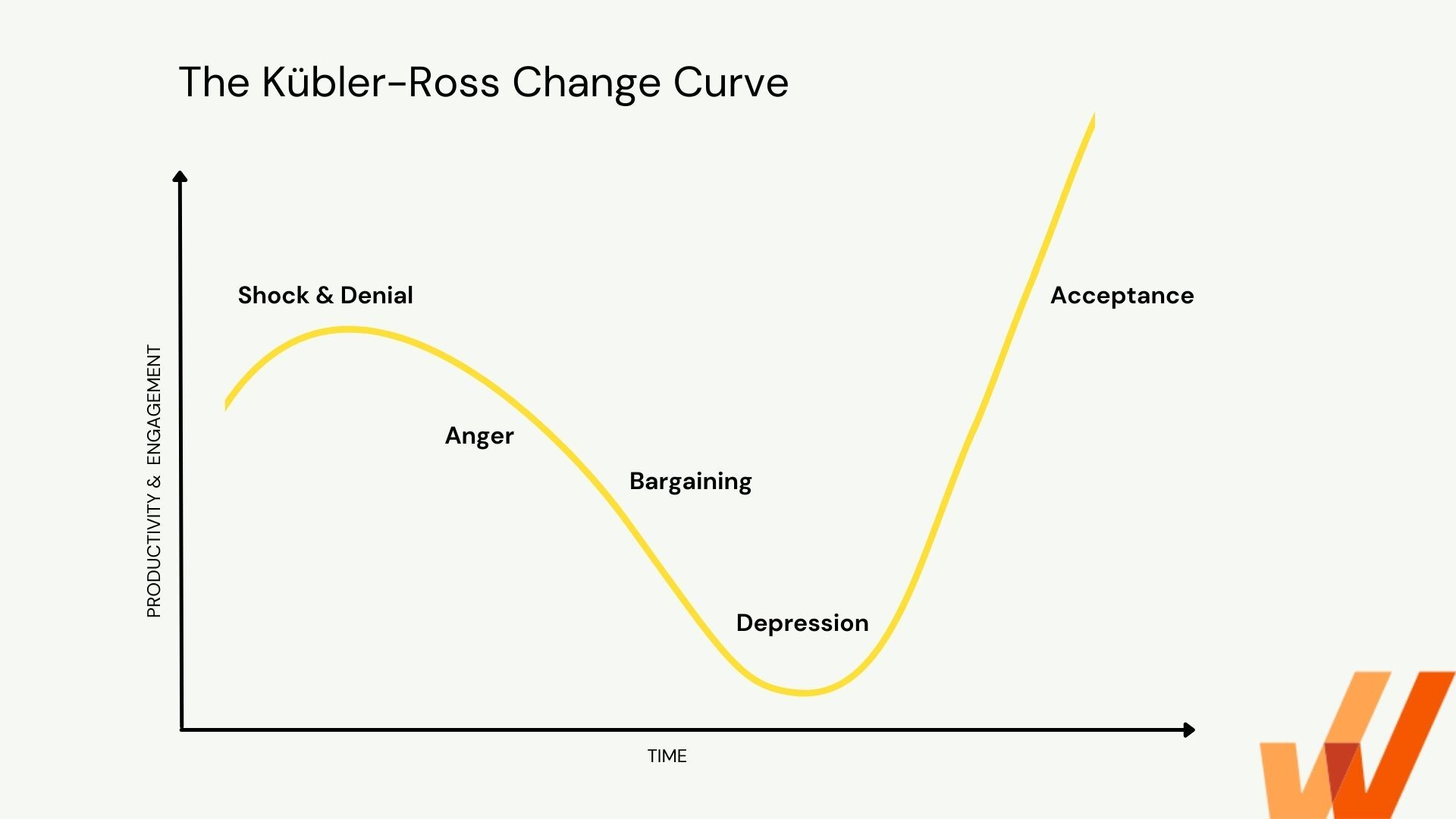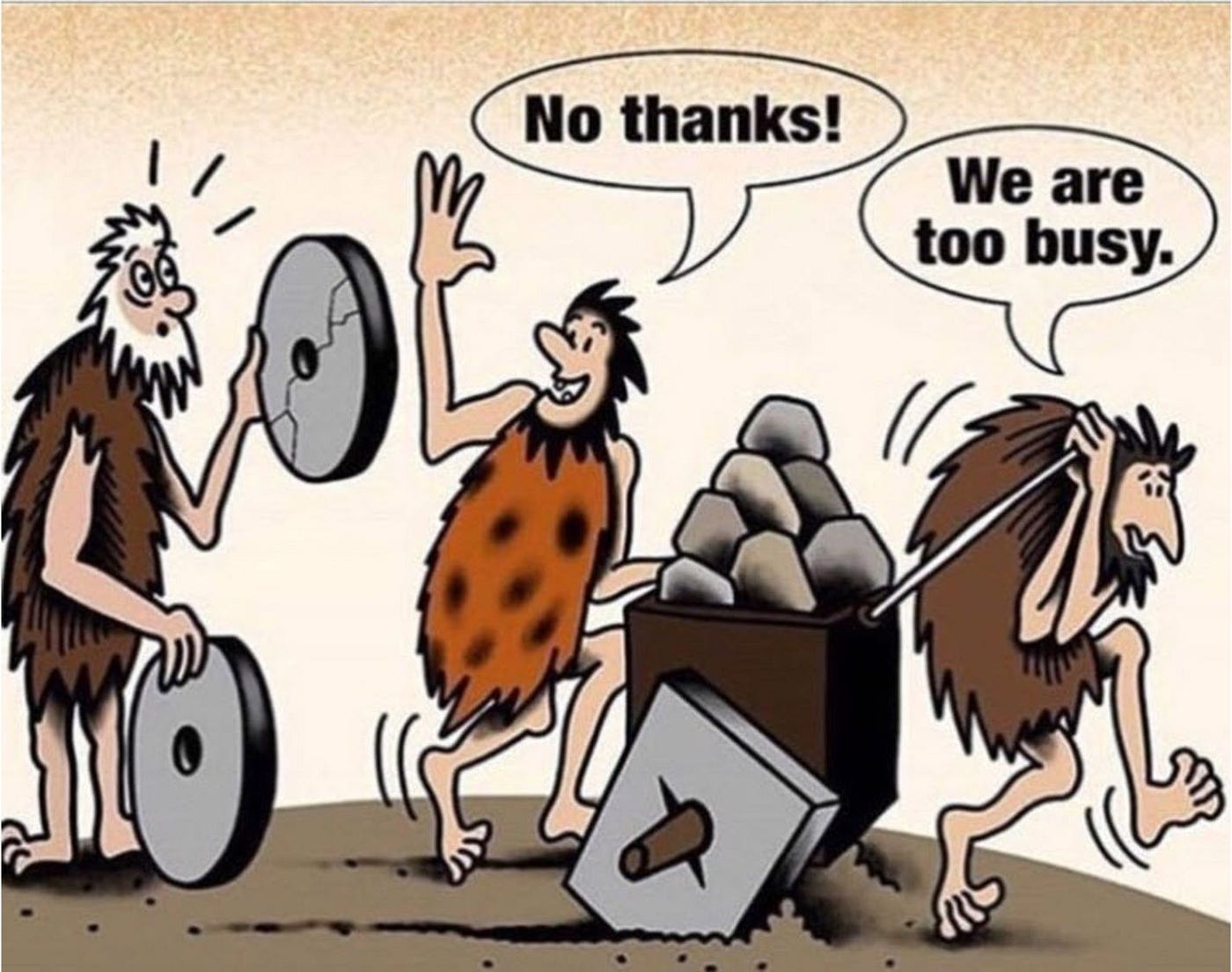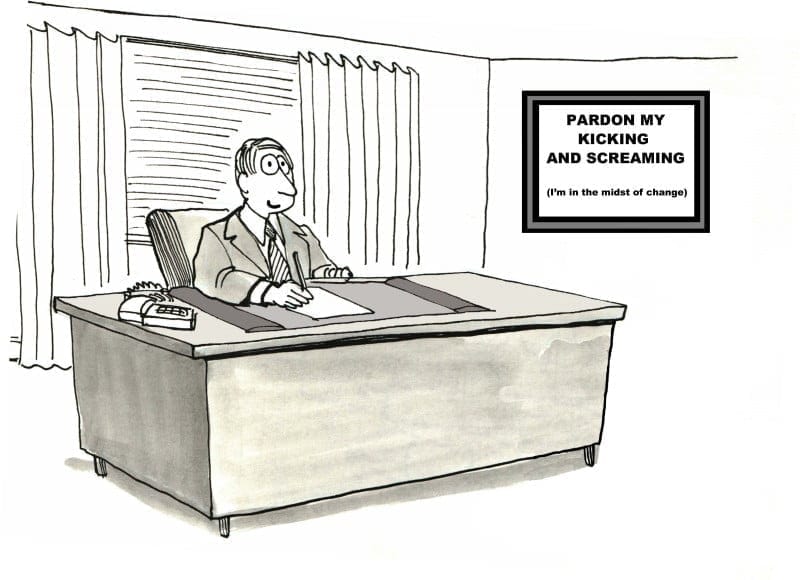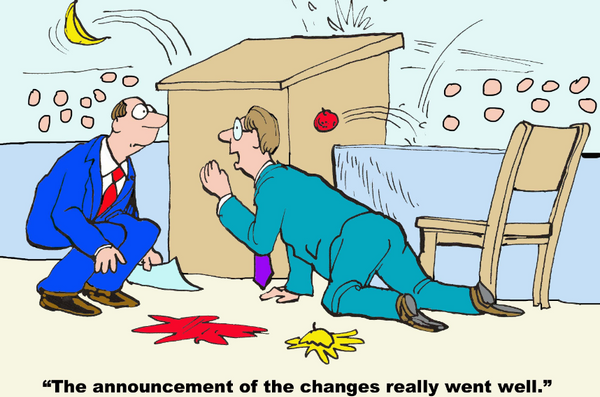What’s Change?
Change is an uncomfortable, almost dirty word for many of us. Whether it’s shifting a long-standing process, updating a legacy system, or—heaven forbid—reconsidering a deeply embedded cultural norm, change always seems to provoke an initial negative response. The first instinct, more often than not, is resistance. It’s as if the human brain is wired to blurt out “nope” before even considering the benefits of shaking things up, Change has a way of provoking an immediate, visceral reaction.
It is like your grandma's old sofa. It’s familiar, a little uncomfortable, but you’ve been sitting on it for years, so why bother switching to something new, even if it’s starting to sag in all the wrong places?
The Cost of Staying Stuck!

It’s as if our collective psyche is wired to push back when anything threatens the familiar, even when the familiar has stopped serving us well. Nowhere is this more evident than in the world of technology. In my own journey through the world of technology—and no, I’m not referring to my misadventures with Bluetooth headphones—I’ve witnessed this resistance to change up close. In fact, twice in the past 20 years, I’ve found myself staring at the same type of IT mess, feeling a deep sense of déjà vu.
One time, it was while working for a UK based client in the early 2000s, and now, it's happening all over again with a sprawling ERP system. Both situations offer perfect illustrations of why change can feel like trying to convince a cat to take a bath: a lot of hissing, clawing, and everyone involved is somehow wetter and angrier by the end.
But this story isn’t just about the nerdy nuts and bolts of IT (don’t worry, I’ll spare you the “techie” jargon), it’s about something bigger. The same resistance that I’ve seen in technology also plays out in society, culture, relationships and even individual mindsets. Why are we so reluctant to let go of what clearly isn’t working? And why does it sometimes take a crisis—whether it’s a system meltdown or a social upheaval—to get us to act?

As we dive into these stories, we’ll explore why change is so hard, how individuals, organizations and societies alike tend to entrench themselves in outdated systems, and what happens when no one smells the coffee until it’s burned beyond recognition.
The Frankenstein Monster
Back in 2003-2004, I found myself working on Tesco’s IT team during what can only be described as a perfect storm of technology chaos. Now, Tesco was never shy about spending money, and they had jumped onto the tech bandwagon early in the game, aiming to lead the pack. But their IT infrastructure? That was a different story altogether—imagine opening a closet so overstuffed that you’re just waiting for everything to collapse on top of you.
Picture this: a landscape of two Mainframes, Citrix farms, NetWare 4 and 5 (who uses it anymore), three flavors of Linux boxes, Windows NT, 2000, XP, loads of middleware and custom applications to make them all talk to each other and—just for fun—some remote desktops still running Windows 3.11 over DOS. Yes, Windows 3.11 & DOS, those relics of the prehistoric tech era. It was like the IT version of the Island of Misfit Toys, and if that sounds like a Frankenstein monster (ask any IT Support chap), you’re right on the money.

Why was it such a mess? Well, Tesco had fallen into the classic trap: every department made their own decisions on what software or hardware they wanted. So, you ended up with marketing using one system, finance using another, meanwhile, the corporate office had grand ideas about what everyone should be using but lacked the necessary roadmap to enforce any meaningful cohesion and the 'IT Guys' quietly kept sobbing in a corner. The result was akin to a tech Frankenstein—only instead of a lightning bolt bringing it to life, it was powered by caffeine, nicotine, duct tape, and sheer desperation.
By the time someone at the top finally smelled the coffee (burnt and over-brewed, naturally), it was too late. Too much time, money, and effort had already been sunk into keeping this ramshackle system running. Redoing everything from scratch was out of the question, so instead, Tesco hired expensive consultants to slap on more duct tape. It worked—sort of. The system limped along, but service disruptions and breakdowns were about as regular as the Chai & Sutta breaks in an Indian IT organization.
For us young engineers and analysts, it was a mixed bag. Sure, we spent countless sleepless nights fighting fires, but we also developed an iron stomach for bad cafeteria coffee and learned more about crisis management than most people do in a lifetime. Fun? Not exactly. But character-building? Absolutely.

We became experts in improvisation, teamwork, and navigating chaos with a straight face, picking up skills that no textbook could teach. The sheer madness of it all forced us to grow faster than we ever expected, and by the end, we could practically manage a system meltdown in our sleep—or more accurately, without sleep. Looking back, it was like being thrown into the deep end of the pool, but by the time we emerged, we weren’t just swimming—we were diving headfirst into the next challenge, battle-hardened and ready for any monster our paths crossed with.

Eventually, after enough meltdowns to fill an IT horror story anthology, someone high enough smelled the coffee and Tesco made the decision to sunset its legacy systems and start fresh. They opened an office in Bangalore, hired top talent, and, by 2009, they had ditched the mainframes and other outdated tech for something sleeker and more modern.
Building and Letting Go
A decade after the Tesco saga, I found myself in a very different role—the shoes of an entrepreneur. Armed with an idea that I was convinced was ahead of its time, I poured my heart, soul, and a fair bit of cash into building something that I believed would change the market. The hardships of starting from scratch weren’t glamorous. In fact, they felt more like assembling IKEA furniture without the manual or those pesky little screws of a laptop that always go missing.
Yet, there was fun too. The joy of shaping something, even when you’re not entirely sure if the pieces will fit together, was intoxicating. I had high hopes of becoming a market leader one day, and I could almost taste the success. But as time passed, reality started to knock on the door—and it wasn’t delivering good news.
I reached a point where I knew, deep down, that the idea wasn’t working. Still, I kept funnelling money, time, and energy into it. Why? Because I wasn’t ready to let go. It wasn’t just a business anymore—it was MY creation. Too much emotion had been invested, and I had no exit strategy in place. I simply couldn’t bring myself to take the tough call. The idea had become like a faulty tech system: I kept hoping that with just a little more investment, a little more tweaking, it would finally click. But in the end, all I had done was prolong the inevitable.

This experience taught me something crucial about change—it’s not just about making smart decisions; it’s about having the courage to admit when it’s time to stop. And, boy, is that easier said than done.
The Modern Debacle
Another decade has passed and I’m right back in the same boat, only this time it’s a bloated ERP system that’s been in development for nine years. It serves nearly 70,000+ users across 90 entities through 40+ modules, but, much like its predecessor at Tesco, it’s a hodgepodge of features and exceptions, held together with whatever the digital equivalent of chewing gum is.
The system has no cohesive design document (probably because no one could figure out what was happening long enough to write one). The architecture is outdated—it doesn’t support server-less architecture so you can say bye-bye to the cloud, and there are hundreds of exceptions patched in to make it sort of work. It’s like trying to run a Formula 1 race with a car that has spare tires from a 1992 HM Ambassador. Oh, and to make things even more fun, we don’t control the code. We’re stuck in a SaaS model where we host the system, but the vendor gets to tinker with the code like they’re playing a video game. Changes in production happen at their whim, and when things go wrong (and they do), we’re left scrambling. We’re at a point where we can’t trust the system, and yet we continue to pour resources, time, and money into keeping it alive, that’s about as trustworthy as a toaster in the bathtub.
Sound familiar? It’s Tesco all over again, only this time, no one has smelled the coffee yet.
Why The Reluctance?
So, why does change feel like such an impossible task? Whether it’s an outdated ERP system or a centuries-old social structure, the reluctance to change comes from a few familiar places:
1. Fear of the Unknown: Change is scary because it involves stepping into the unknown. Will the new system work? Will it break things even more? Will I finally be forced to admit that I don’t know how to use that fancy new software? These fears are real, but they’re often exaggerated in our minds.
2. Investment in the Status Quo: Once we’ve spent significant time, money, and emotional energy on something, it becomes incredibly hard to let go. This is the sunk cost fallacy at work—we keep thinking, “Well, I’ve already invested this much, might as well keep going,” even when it’s clearly not working.
3. Cultural Inertia: Traditions, whether technological or societal, become embedded in our identities. Changing them feels like a threat to the very core of who we are. So instead of evolving, we dig our heels in, like a toddler refusing to eat their vegetables.
4. Lack of Foresight: Often, organizations don’t plan for obsolescence. They don’t have an exit strategy in place, so when the system (or social structure) inevitably outlives its usefulness, everyone panics.

The Slow Death
This isn’t just about technology. Societies and cultures face the same problem. Think about a tradition or social norm that’s clearly outdated. Why do people cling to it? Because, much like that ERP system, it’s comfortable. It’s what they know. Whether it’s an antiquated legal system, an educational model from the 19th century, or social customs that haven’t adapted to modern times, these systems hang on long past their expiration date.

But much like outdated technology, these systems don’t die quickly. They drag on, slowly decaying, creating friction and inefficiency in every area they touch. At some point, change becomes inevitable. Whether it’s a revolution, an overdue reform, or just a belated software update, the old ways eventually give way to something new. The question is whether we embrace that change or get dragged into it kicking and screaming.
Don’t wait until it’s Too Late
In the tech world, the cost of staying stuck is felt in system downtime, service disruptions, and, ultimately, lost revenue. But it’s no different in society. Clinging to outdated traditions or systems leads to stagnation and, eventually, collapse. The problem is, we often don’t realize the cost until it’s too late.
The warning signs are always there. Whether it’s a buggy ERP system or a social system that no longer serves its purpose, the cracks start showing long before the system collapses. But instead of addressing the problem, we patch it up and hope for the best. And then we act surprised when everything falls apart.

It doesn’t have to be this way. Change, while uncomfortable, doesn’t have to be painful. In fact, the earlier we recognize the need for change, the smoother the transition can be. Tesco learned that lesson the hard way, and my current ERP saga is shaping up to follow the same script. The question is, will we act before it’s too late, or will we continue duct-taping our way to disaster?
Smell the Coffee
Change is hard, yes, but it’s also inevitable. The sooner we accept that, the easier it becomes to embrace. Whether its technological infrastructure, social systems, or personal habits, staying stuck in the past comes with a cost—and that cost only grows the longer we avoid the issue.
So, the next time you’re staring down the barrel of change, whether it’s upgrading a system or rethinking a long-standing tradition, or letting go a habit, take a deep breath and remember: it’s better to smell the coffee before it burns. Because if there’s one thing we’ve learned from our various experiences, it’s that avoiding change only leads to more sleepless nights—and nobody likes the taste of burned coffee at 3 a.m.



